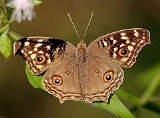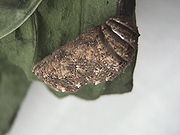
Junonia lemonias
Encyclopedia
_at_jayanti,_duars,_west_bengal_w_img_5631.jpg)
South Asia
South Asia, also known as Southern Asia, is the southern region of the Asian continent, which comprises the sub-Himalayan countries and, for some authorities , also includes the adjoining countries to the west and the east...
. It is found in gardens, fallow land, and open wooded areas.
_i_img_9650_.jpg)
Description

In the dry season form the markings are obscure and pale especially on the underside and the wing margin is more angular and jagged. This helps it camouflage
Camouflage
Camouflage is a method of concealment that allows an otherwise visible animal, military vehicle, or other object to remain unnoticed, by blending with its environment. Examples include a leopard's spotted coat, the battledress of a modern soldier and a leaf-mimic butterfly...
in the dried leaf-litter.
The Lemon pansy is a very active butterfly and can be seen bask
Bask
Bask, bred at the Albigowa State Stud in Poland and foaled in 1956, was a bay Arabian stallion who was imported into the United States in 1963 by Dr. Eugene LaCroix of Lasma Arabians and became a major sire of significance in the Arabian breed....
ing with its wings open facing the sun. It sits very low to the ground and can be approached easily. It feeds with its wings half open. It is a fairly strong flier and flies close to the ground with rapid wingbeats and often returns to settle back in the same spots.
Eggs
Eggs are laid singly on the underside of leaves. The egg is green and barrel-shaped with longitudinal ridges.Caterpillar
The caterpillar is cylindrical, uniformly thick and covered with rows of spines which are branched at the tip. It is dull black with a faint blue sheen and has dorsal stripe of a darker color. There is a distinct orange ring behind the head. The caterpillar stays on the underside of the leaf and if disturbed, rolls up and drops to the ground.Pupa

Pupa
A pupa is the life stage of some insects undergoing transformation. The pupal stage is found only in holometabolous insects, those that undergo a complete metamorphosis, going through four life stages; embryo, larva, pupa and imago...
is compact, with small conical processes on its rough surface. The pupa is well camouflaged with varying shades of brown with fine streaks and lines.
Foodplants
Caterpillars feed on plants from the families AcanthaceaeAcanthaceae
The family Acanthaceae is a taxon of dicotyledonous flowering plants containing almost 250 genera and about 2500 species....
, Amaranthaceae
Amaranthaceae
The flowering plant family Amaranthaceae, the Amaranth family, contains about 176 genera and 2,400 species.- Description :Most of these species are herbs or subshrubs; very few are trees or climbers. Some species are succulent....
, Malvaceae
Malvaceae
Malvaceae, or the mallow family, is a family of flowering plants containing over 200 genera with close to 2,300 species. Judd & al. Well known members of this family include okra, jute and cacao...
, Rubiaceae
Rubiaceae
The Rubiaceae is a family of flowering plants, variously called the coffee family, madder family, or bedstraw family. The group contains many commonly known plants, including the economically important coffee , quinine , and gambier , and the horticulturally valuable madder , west indian jasmine ,...
, Tiliaceae
Tiliaceae
Tiliaceae is a botanical name for a family of flowering plants. Such a family is not part of APG II, but it is found all through the botanical literature and remains prominently listed by nomenclatural databases such as IPNI....
and Verbenaceae
Verbenaceae
Verbenaceae, commonly known as the verbena family or vervain family, is a family of mainly tropical flowering plants. It contains trees, shrubs and herbs notable for heads, spikes, or clusters of small flowers, many of which have an aromatic smell.Recent phylogenetic studies have shown that...
. Recorded species include Alternanthera sessilis
Alternanthera sessilis
Alternanthera sessilis is an aquatic plant known by several common names, including sessile joyweed and dwarf copperleaf. It is used as an aquarium plant.The plant occurs around the world....
, Barleria cristata
Barleria cristata
Barleria cristata , is a plant of the Acanthaceae family.-Distribution and habitat:It is native to a wide area raanging from Southern China to India and Myanmar....
, Barleria prionitis
Barleria prionitis
Barleria prionitis, the porcupine flower, is a species of plants in the family Acanthaceae native from India....
, Blechum pyramidatum, Cannabis sativa
Cannabis sativa
Cannabis sativa is an annual herbaceous plant in the Cannabaceae family. Humans have cultivated this herb throughout recorded history as a source of industrial fibre, seed oil, food, recreation, spiritual enlightenment and medicine...
, Corchorus capsularis, Dyschoriste repens, Eranthemum pulchellum
Eranthemum pulchellum
Eranthemum pulchellum is a strongly branched shrub, popular with gardeners in tropical India and China because of the spikes of flowers that are bright gentian blue - an unusual color in the tropics...
, Hemigraphis schomburgkii, Hygrophila auriculata
Hygrophila auriculata
Hygrophila auriculata is a plant in the acanthus family. It is native to India and commonly known as marsh barbel....
, Hygrophila costata
Hygrophila costata
Glush weed , or yerba de hicotea Glush weed (aka gulf swampweed), or yerba de hicotea Glush weed (aka gulf swampweed), or yerba de hicotea (syn. Hygrophila atricheta Bridar., Hygrophila brasiliensis Spreng., Hygrophila conferta Nees, Hygrophila guianensis Nees, Hygrophila lacustris Morong &...
, Hygrophila lancea, Lepidagathis formosensis, Lepidagathis incurva, Nelsonia canescens, Ophiorrhiza japonica, Phyla nodiflora
Phyla nodiflora
Phyla nodiflora , is an ornamental plant in the Verbenaceae family, which is native from soud amrican and United States. It can be found in tropical areas around the globe, a naturalized species in many places...
, Ruellia tuberosa
Ruellia tuberosa
Ruellia tuberosa, also known as Minnie Root, Fever Root, Snapdragon Root and Sheep Potato , is a species of flowering plant in the Acanthaceae family...
, Sida rhombifolia
Sida rhombifolia
Sida rhombifolia is a perennial or sometimes annual plant in the Family Malvaceae, native to the New World tropics and subtropics. Other common names include Paddy’s lucerne, jelly leaf, and also somewhat confusingly as Cuban jute, Queensland hemp, and Indian hemp Sida rhombifolia (Arrowleaf...
and Strobilanthes formosanus.

